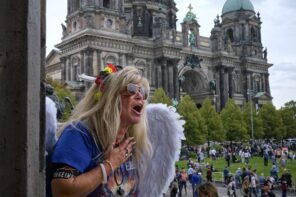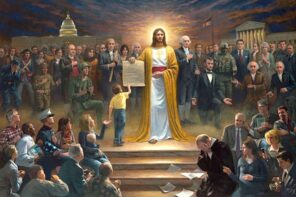When Arizona Governor Jan Brewer signed the controversial immigration law last week, for some it conjured images of “Nazism” and the Jim Crow South. I believe the more apt image of this law can be found in rapper MIA’s new video, “Born Free” (warning: nudity, graphic violence, NSFW).
In an uncanny coincidence, the video, directed by filmmaker Romain Gavaras, depicts redheaded men—“gingers”—being rounded up in an ICE-style sting in Los Angeles, transported out into the desert by bus, and forced to run for their lives. The intent was to show the brutality of the American occupation in Iraq and Afghanistan, though it’s being read by some as a prescient trope about the perils of Arizona’s new immigration law whose opponents claim that its vagueness will result in racial profiling. “I don’t think there’s any doubt about that,” Secretary of State Hillary Clinton told David Gregory on Meet the Press Sunday morning.
How religious groups will (or will not) organize for or against the Arizona law remains to be seen, but if the president of the National Hispanic Christian Leadership Conference (NHCLC), Rev. Samuel Rodriguez, and others are any indication, this could spoil the nascent coalition between the Republican Party and the Tea Party Movement or throw a wrench into the religious right’s outreach to ethnic communities. The confluence of race, religion, and nation—familiar territory for Americans—may divide religious groups into irreparable factions and provide another fracture in the GOP’s strategy for the 2010 and 2012 elections.
It’s ironic, then, that state officials in Arizona have not learned from their own recent history that unjust immigration laws tend to mobilize individuals and religious groups. The Sanctuary movement, started in Arizona in the early 1980s by Jim Fife and John Corbett, sought to help political refugees from Central America who were fleeing human and civil rights violations. Churches and synagogues engaged in civil disobedience by providing shelter as well as financial and social assistance to the refugees.
Based on principles of liberation theology, the movement provided a place for “illegal” immigrants to be housed while re-starting their lives in the United States. The federal government (which had at first left the movement alone) began to infiltrate churches, taping meetings and arresting participants. In several cases the government was able to prosecute and imprison members of the Sanctuary movement, though they continued to have success helping immigrants well into the 1990s.
In 2006, Cardinal Roger Mahony of the Archdiocese of Los Angeles refused to abide by a proposed bill to criminalize assistance without first checking the immigration status of an individual. Out of that refusal the New Sanctuary Movement was founded “to respond to the needs of immigrant workers and their families and to support coalitions working on comprehensive immigration reform.” The NSM now has several active chapters across the United States—including Arizona.
When the movement first formed back in the 1980s the situation was different. The political landscape and religious fault lines have changed, but most notable is the unlikely coalition-building taking place both for immigration reform and against it. While some assume that most conservative Christians support tougher immigration laws, figures like the aforementioned Rev. Samuel Rodriguez, an Assemblies of God minister, have been vocal proponents of more humane immigration reform. Rodriguez, courted by many as a power broker for Latino voters, does not possess the traditional religious right profile. His partnership with the National Association of Evangelicals, Jim Wallis, and others will form a formidable juggernaut against supporters of the immigration law who claim “Christian principles.”
In the ranks of the United States Catholic Church, immigration proponents like Cardinal Roger Mahony will find themselves pitted against conservatives; though the high-profile sexual abuse scandal may also make it a less formidable adversary to the movement for immigration reform.
The only Hispanic to vote for SB 1070 is Arizona State Representative Rev. Steve B. Montenegro, a minster in the Apostolic Assembly church—a Oneness Pentecostal denomination with a large Mexican and Mexican-American population. Montenegro, an El Salvadorian immigrant, fled to America with his parents and was granted religious asylum status enabling him to become a citizen. His parents were assisted in that process by obtaining papers from Apostolic Assembly.
Ironically, Montenegro’s position as a right-wing Republican and ardent Tea Party supporter places him in the hypocritical position of shutting the doors to many Apostolic Assembly members who have supported him in the ministry, yet are in the country without “proper documentation.” His pro-SB 1070 vote has aroused considerable ire in Hispanic circles. It remains to be seen how Hispanic leaders like Rodriguez will deal with him, but I suspect it will not be pleasant.
Is there something in the air in Arizona that breeds racial division? Given the current situation and the notable struggle to establish Martin Luther King Jr. Day as a national holiday (enshrined in the Public Enemy song “By the Time I get to Arizona”), it’s no wonder that the current immigration law is being called the “Hispanic Civil Rights Movement.” As Antonio Gonzalez head of the Southwest Voter’s Education Project stated, drawing parallels to the black civil rights protests of the 1960s: “For Hispanics, Arizona is Alabama and Maricopa County is Selma.” And much like the civil rights movement, Arizona’s draconian immigration law promises to divide religious groups into factions that won’t easily be repaired.
The violence portrayed in MIA’s “Born Free” and Public Enemy’s “By the Time I get to Arizona” isn’t likely to break out anytime soon, but the tensions they depict are present in the fight for the recognition of undocumented immigrants—the vast majority of whom are honest people trying to make a better life for their families. What could be more American?




